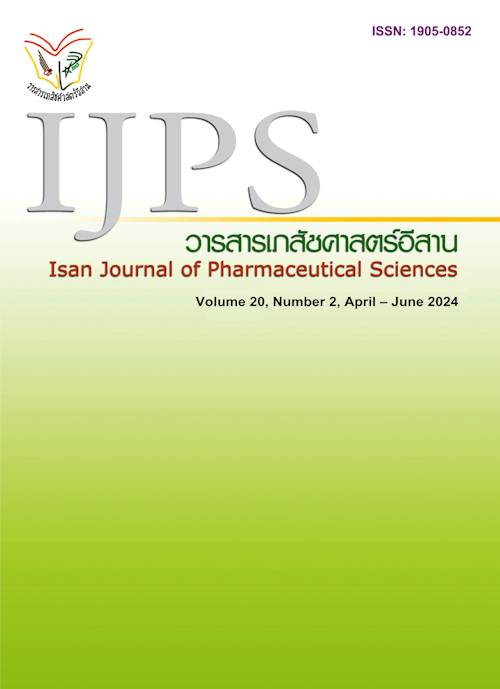The study of quantity and value of Herbal and Thai Traditional Medicines Use in Sunpasitthiprasong Hospital
Main Article Content
Abstract
Thai society has a long history of using herbal medicine. The Ministry of Public Health and related agencies have established policies for the continuous development of herbal medicine. One of the strategies for this development is to promote the use of herbal medicine for disease treatment and health enhancement. Therefore, the use of herbal medicines in various hospitals has been promoted to support the policy of herbal medicine development. Objectives: 1. To analyze the quantity and value of the use of herbal and traditional Thai medicines in hospitals and among specific groups of physicians 2. To analyze a case study of the utilization of Fa Talai Jone (Andrographis paniculata) herbal medicine during the COVID-19 pandemic in Sunpasitthiprasong Hospital. Materials and methods: This research is quantitative research. It analyzes data regarding the use of herbal medicine and Thai traditional medicine at Sunpasitthiprasong Hospital from the fiscal year 2019-2021 by collecting data from the hospital's database and analyzing the data using descriptive statistics. Results: It was found that the percentage of outpatient services for examination, diagnosis, treatment, and rehabilitation with Thai traditional medicine and alternative medicine, compared to all outpatients in fiscal years 2019, 2020, and 2021, were 4.66%, 5.21%, and 6.25%, respectively. The groups of physicians with the highest usage of herbal medicines were in three main categories: social medicine, internal medicine, and surgery. Additionally, the total value of herbal medicine used at the Saraburi Hospital in the years 2019, 2020, and 2021 were approximately 1.46 million, 1.38 million, and 1.54 million Baht, respectively. When considering the use of Fah Talai Jone (Andrographis paniculata), an herb recommended by the Ministry of Public Health for use during the COVID-19 outbreak, it was found that its usage increased. Conclusion: The group with the highest usage of herbal medicines is the Social Medicine Department. The top three herbs with the highest prescription volume are turmeric, Andrographis paniculata, and plai cream. Additionally, the use of Andrographis paniculata increased tenfold during the COVID-19 outbreak compared to normal periods.
Article Details

This work is licensed under a Creative Commons Attribution-NonCommercial-NoDerivatives 4.0 International License.
In the case that some parts are used by others The author must Confirm that obtaining permission to use some of the original authors. And must attach evidence That the permission has been included
References
Benjaponpitak A, Sawaengtham T, Thaneerat T, Wanaratna K, Chotsiri P, Rungsawang C, et al. (2023). Effect of Andrographis paniculata treatment for nonimmune patients with early-Stage COVID-19 on the prevention of pneumonia: a retrospective cohort study. Archives of Internal Medicine Research 6(2): 35-43.
Chaikoolvatana A, Chandee S, Chaikoolvatana C, Sithibutra C (2015). A comparison of smoking cessation drug therapies related quality of life between Vernonia cinerea tea and 0.5% sodium nitrate mouthwash. Nursing journal 43: 94-104.
Chokevivat V, Chuthaputti A, Khumtrakul P (2005). The use of traditional medicine in the Thai health care system. Region consultation on development of Traditional medicine in the South East Asia region, Pyongyang, DPR Korea: 22-24.
Chokwarakul C (2021). Local Herbs against COVID-19 Virus. RSU International Research Conference 2021.
Harinawan P, Damnoenssawat W, Srikajang P, Maneewong N (2009). Usage of Herbal Alternatives to Modern Medicine in Lampang Hospital and Community Hospitals in Lampang Province. Journal of Health Systems Research 3(3): 412-418.
Jungsomjatepaisal P (2019). Development of a Prototype for Promoting the Use of Herbal Medicine in Households in Thailand. Journal of Health Science 28(6): 1092-1103.
Kitchalow P, Wayurakul W (2022). Factors related to prescribing herbal medicines listed in national list of essential medicines among hospital-based physicians in Pathumthani province. Research and Development Health System J 15(2): 145-158.
Kulthanit W, Pornvimol L, Nitapha I, Wararath C, Pantitra S, Anutida T, et al. (2021). Efficacy and safety of Andrographis paniculata extract in patients with mild COVID-19: A randomized controlled trial. medRxiv: 2021.2007.2008.21259912.
Meksawasdichai C (2019). Evaluation of policies promoting the use of herbal medicine in hospitals. In the Ministry of Public Health in Saraburi Province in 2017. Journal of Traditional Thai and Alternative Medicine 17(3): 516-526.
National Strategic Committee Secretariat of the Prime Minister (2017). The 20-year national strategic plan (2017-2037). Bangkok, Office of the National Economic and Social Development Board.
Phengbunchoo L, Rungpragayphan S (2023). Analysis of patterns of herbal medicine use in outpatients of health service units in Samut Songkhram using business intelligence system. Thai Journal of Pharmacy Practice 15(1): 167-186.
Sanalad R, Kittiboonyakun P (2020). Development of guidance for supporting the use of National Lists of Thai Herbal Medicines in community Hospitals, Mahasarakham Province, Mahasarakham University.
Sanalad R, Kittiboonyakun P, Nualkaew S (2021). Effects of the intervention for promoting the prescribing of herbal medicines in the national lists of essential medicines in community hospitals at Mahasarakham Province. Thai Journal of Pharmacy Practice 13(4): 933-943.
Suriyawittayawate C (2019). From National Strategy 20 years to National Master Plan for Thai Herbs Development by Integrating Agricultural Education. Journal of Industrial Education 18(1): 240-250.
Tosanguan K, Kapol N, Thavorncharoensap M, Suksomboon N, Kulpeng K, Tantivess S, et al. (2011). Views of health professionals on herbal medicine and policy for promotion of herbal medicine use in healthcare settings. Journal of Health Systems Research 5(4): 513-521.
Vorapani T, Vorapani P (2022). Situation of Thai Traditional Medicine Service and Herbal Medicines using in Government Public Health Facilities of the Regional Health 2. Rajabhat Chiang Mai Research Journal 23(1): 140-158.


